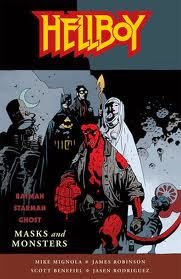 Melanie is a bright ten
year old, a bright girl who lives to learn and adores her best
teacher, Miss Justineau. Every morning she's taken to classes; taken
from her cell by armed soldiers; strapped up like Hannibal Lecter;
transported in a wheelchair. Melanie has never been outside, but she
lives in an old air base, and isolated fort in a Britain overcome by
a deadly spore that has turned much of the population into
'hungries': zombie-like humans who remain listless until the smell of
human flesh sends them into a piranha-like feeding frenzy. The
uninfected are clustered in a city on the south coast and in this
isolated research centre. Going out means facing the hungries, and
also the 'junkers', humans who chose not to retreat, but live out in
the world avoiding or battling the hungries.
Melanie is a bright ten
year old, a bright girl who lives to learn and adores her best
teacher, Miss Justineau. Every morning she's taken to classes; taken
from her cell by armed soldiers; strapped up like Hannibal Lecter;
transported in a wheelchair. Melanie has never been outside, but she
lives in an old air base, and isolated fort in a Britain overcome by
a deadly spore that has turned much of the population into
'hungries': zombie-like humans who remain listless until the smell of
human flesh sends them into a piranha-like feeding frenzy. The
uninfected are clustered in a city on the south coast and in this
isolated research centre. Going out means facing the hungries, and
also the 'junkers', humans who chose not to retreat, but live out in
the world avoiding or battling the hungries.
I haven't enjoyed an
sf/horror novel so much in ages. It's a take on a number of familiar
tropes, but Mike Carey's novel works in two sections, and draws on
two strands of modern speculative fiction. The first, and obvious
strand, is dystopian, apocalyptic science fiction, something which
has been particularly attractive to British writers at least from the days of
HG Wells. Why the British have proved so ultimately resistant to
utopias, something Americans have always found tempting, might have
something to do with innate pessimism, or disdain for the idea that
one's life or station in life can be improved, or maybe simply an
expression of what George Mikes identified as the greatest joy in
English life: enduring hardship, and the most satisfying hardship to
endure was unnecessary hardship.
This dystopian Britain
recalls elements of our present day too, and remember that our
present day is one dominated by fantasies of vampires and zombies.
The former, which is easier to understand, given the obvious sexual
undercurrent of vampirism, has given way almost naturally to the
latter—why are zombies so popular in modern culture? Do they show
us something about ourselves, something lacking perhaps? Or something
about a society with only one major value? Certainly when Mrs
Thatcher said there is no society, only people with interests, she
could be describing a world of hungries.
In the first part of
this novel, Carey sets the scene, bit by bit explaining what has
happened and exactly what is going on in Britain and at the base, and
what the secret of Melanie and her fellow children is. The other part
of the story is a more standard race against the inevitable, survival
in a world of destruction, but the brilliance of the tale is that
there are issues beyond the survival of the people that keep the conflicts
alive.
It's a superlative
piece of writing. Carey is just as effective with his military men,
his mad scientists, as he is with Melanie, who is the lynch pin of
the narration as well as of the story. She is a wonderful creation, a
10 year old coping with curse of unfulfilled intelligence, and
ultimately having to figure things out and make huge decisions
herself. It's both thrilling in the knuckle-whitening horror sense,
and in the sense of the larger personal dilemma, and it is resolved in
a way that reminds you that Carey is a comic book writer of some note (I don't mean this in a deprecating way, as I recall particularly his writing on Lucifer, but simply because graphic stories do tend to have endings that work out--I also wonder why the need be M.R. Carey for this book, thought the name does suggest something in the way of Victorian fantasy). So what I meant to say was the resolution is clever enough to please everyone from old-fashioned sf readers who
want their science believable to those who've become invested
emotionally with Melanie, and are rooting for her survival. Which should be anyone who reads.
The Girl With All The Gifts by M.R.Carey
Orbit, £12.99 ISBN 9780356502731
















